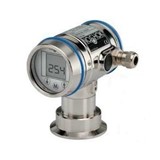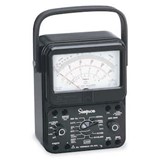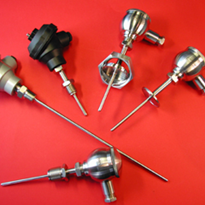The temperature information is converted into a digital number format in the TC-003 so that electrical noise does not alter the temperature indication.
All of the high precision measurement and conversions are performed by the TC003.
Conventional systems using analog 4-20mA RTD transmitters have a number of sources of potential errors. Temperature drift and errors in the transmitter, electrical interference in the analog signal, and measuring errors and drift in the PLC or computer analog inputs all contribute.
Careful inspection of the specifications of PLC analog input cards will show that some types have a specified error of up to 0.5% at high ambient temperatures.
Sensor type:
The TC-003 has been developed to use the industry standard PT100 RTD sensor for process temperature. The PT100 sensor is constructed from purified platinum, and its temperature measuring relies on the electrical properties of the platinum. Platinum is a stable and non-corroding metal so that its properties will remain constant over time.
The electrical behavior in relation to temperature is well known, and is published by International Standards authorities as the basis for the determination of temperature for highly accurate scientific work. The resistance change with temperature is not exactly linear, but it follows a mild parabolic curve for which scientific research has given a
practically exact formula. The microprocessor in the TC-003 is programmed with this formula, so that it can give a precise temperature measurement over a wide temperature range of -100°C to +850°C.
It is interesting to note that many analog RTD (4-20mA) transmitters do not compensate for this curve and so their calibration process requires a compromise to minimize the error, but it cannot eliminate it. Practically this means that the curve is ignored and the resulting errors are accepted, especially if the users are unaware of this behavior.
Accuracy:
The TC003 is designed so that it has no calibration controls and its output depends solely on its 0.1% precision reference component. There are no controls that can be incorrectly adjusted.
Other designs must be calibrated in manufacture by connecting reference signals and adjusting the span and zero controls. The delivered transmitter accuracy will depend on the accuracy of the reference signals and the care of the operator, and may drift over time and temperature.
Stability:
There are two areas to consider in relation to the long-term accuracy of the temperature measuring system. Both the sensor element and the measuring electronics must be stable over time and in relation to ambient variations of temperature and other factors such as
supply voltage.
Sensor:
The platinum PT100 RTD uses a pure non-corroding metal as the sensor. The chemical and crystal structures do not change over time and so the sensor will remain stable and give repeatable measurements over a long time.
Transmitter:
All electronic components and circuits are affected by temperature to some degree. This can cause a temperature transmitter to give a signal variation due to the variation in ambient temperature of the transmitter. This could easily range from 0°C to 40°C in an outdoor environment.
A transmitter that acts as an analog to digital converter must have components that act as a reference for the measurement of the temperature and conversion to a number. If the reference changes in value, then the output for a given temperature will change. This is exactly the same as if one uses a measuring tape that can stretch, where the measurement of a fixed distance would change as the tape was stretched.
The TC003 uses a super precision circuit arrangement that automatically performs span and zero calibration of all of its circuitry in relation to its internal reference before every temperature reading, in other words once every eight seconds. This means that any circuit variations, apart from the reference, have no effect on the output.
The reference component in the TC003 has an initial tolerance of 0.1% of the ideal value at 20°C, and it has a temperature variation of no more than 15 parts per million per degree C. This means that at 0°C the value will change no more than 20°C times 15, or 300 parts per million, or 0.03%, and similarly for 40°C.
This arrangement is so effective that the TC003 needs no calibration adjustments, not even in manufacture. It does not have any calibration controls. Only the reference component needs to be stable, and choosing a costly, high precision component ensures this.
Calibration:
True temperature calibration is awkward and time consuming, subjecting the probe to carefully controlled and measured temperature conditions and allowing plenty of time for the probe temperature to stabilize. It is necessary to have a reference sensor that is known to be more accurate than the calibration result required, and to have a stable temperature controlled reference bath or block. It is also important to ensure that the reference sensor and the one under test are at exactly the same temperature. This is difficult to guarantee when the desired accuracy is a fraction of a degree.
When there are hundreds of probes, it becomes a major exercise. Anything that helps to minimize the need for calibration saves a lot of time and cost.
The TC003 is designed to need no calibration at all, and no controls are provided. Its operation can be checked by a normal PT100 RTD simulator or with a precision resistor. The PT100 RTD is stable and can also be checked if necessary with normal instruments. Because the TC003 requires no calibration, any standard PT100 RTD sensor can be substituted.
Range:
The TC003 uses platinum PT100 RTD sensor that in various forms can be used from -200° C to 850°C. The housing and the mountings are the limiting factors. The microprocessor is programmed with the resistance curve from -100°C to 850°C and can be used anywhere in this range without adjustment.
Installation and environment:
The TC003 uses high quality cage clamp screw terminals, with plated metal surfaces to minimize corrosion. The cage clamp design ensures that the clamping screws cannot cut the wires or damage pin lugs, and provides a built in spring force to ensure that the terminal connection does not become loose over time.
Other transmitter designs use brass screws or miniature screw terminals. The miniature screw terminals are fiddly to wire correctly and easy to damage. The brass screws are more robust but may allow the installer to damage the internal printed circuit board in the transmitter if over-tightened, and they are more difficult to wire. The brass screws
alsomake it harder to insure that the terminals do not become loose over time.
The entire electronics of the TC003 is encapsulated in a soft silicone rubber compound, which is applied in liquid form to ensure that the housing is fully filled. This silicone rubber has the traditional water-repellent properties of silicone compounds, so it fully protects the electronics from water and condensation.
The relatively soft rubber ensures that differential thermal expansion over a wide temperature range does not result in the potting compound causing mechanical damage to the electronics. Other types of potting compound are not recommended for use over wide temperature ranges because of the risk of mechanical damage to the electronics.
In summary:
The Temperature control hardware carries a cost. But when considered in the overall investment, it is only a small component.
Do not sacrifice a LONG TERM saving in operating cost with loss of Quality Control, for a short term saving in the initial selection of Temperature Sensors and Transmitters.
PROTECT YOUR INVESTMENT by purchasing the TCOO3/PT100 Analog to pulse Temperature Probe.



























